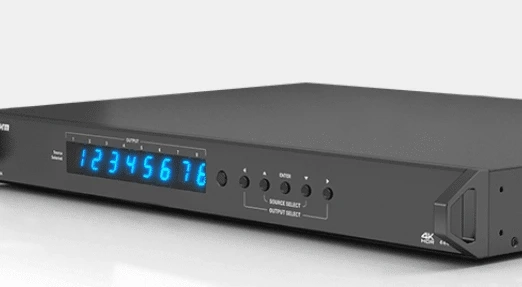The need for flexibility and seamless connectivity is paramount in the world of audiovisual setups. This is where HDMI matrices come into play, offering the ability to route HDMI signals from multiple sources to various displays. Whether you\'re setting up a home theatre, conference room, or digital signage network, selecting the right HDMI matrix is crucial. With myriad options available, it\'s important to consider factors such as the number of inputs and outputs, resolution support, audio options, and control methods. This guide helps you navigate the selection process and make an informed decision.
Factors to Consider When Choosing an HDMI Matrix
- Number of Inputs and Outputs: The first step is determining how many HDMI sources (inputs) you need to connect and how many displays (outputs) you intend to use. Choose a matrix with enough input and output ports to accommodate your setup. Remember that having a few extra ports is better than running out of them.
- Resolution Support: Check the matrix\'s compatibility with the resolutions you plan to use. Modern matrices support Full HD (1080p), 4K, and 8K. Ensure that the matrix can handle the highest resolution of your sources and displays.
- Audio Options: If you\'re routing audio and video, consider the audio options the matrix supports. Look for features like audio extraction, audio embedding, and support for various audio formats (such as Dolby Atmos or DTS-HD Master Audio).
- Control Methods: Different matrices offer different control methods for selecting sources and routing signals. Common options include remote control, front panel buttons, RS-232 serial control, and IP control via Ethernet. Choose a control method that aligns with your preferences and setup requirements.
- EDID Management: EDID (Extended Display Identification Data) is essential for proper communication between sources and displays. A good HDMI matrix should offer EDID management, allowing you to customize EDID settings to ensure optimal compatibility.
- Switching Speed: The switching speed of an HDMI matrix determines how quickly it can switch between sources and displays. For applications where fast switching is crucial, such as live events or presentations, look for a matrix with quick response times.
- Matrix Type: HDMI matrices come in various configurations, such as 4x2, 8x8, and more. The first number represents the number of inputs, while the second represents the number of outputs. Choose a matrix size that matches your setup\'s requirements.
- HDCP Compliance: HDCP (High-bandwidth Digital Content Protection) is essential for secure content transmission. Ensure that your HDMI matrix is HDCP compliant to avoid compatibility issues with protected content.
Selecting the Right HDMI Matrix for Your Setup
- Small Home Theater Setup: If you have a modest home theatre setup with a few sources (like a Blu-ray player, game console, and streaming device) and one or two displays, a 4x2 or 4x4 HDMI matrix should suffice.
- Conference Room or Classroom: For larger setups like conference rooms or classrooms, consider matrices with more inputs and outputs (e.g., 8x8 or 16x16). This accommodates multiple sources, displays, and even more complex routing scenarios.
- Digital Signage Network: In digital signage applications, scalability is key. Opt for a matrix that supports many inputs and outputs and reliable remote control options for easy content management.
- Entertainment Room: If you\'re setting up a dedicated entertainment room with multiple screens, a larger matrix (e.g., 8x8 or 16x16) will allow you to route different sources to different displays effortlessly.
Choosing the right HDMI matrix is critical in creating a seamless and flexible audiovisual setup. The right HDMI matrix can elevate the audiovisual experience and provide connectivity and control. So, take the time to assess your needs, explore your options, and select the HDMI matrix that aligns perfectly with your setup goals.


